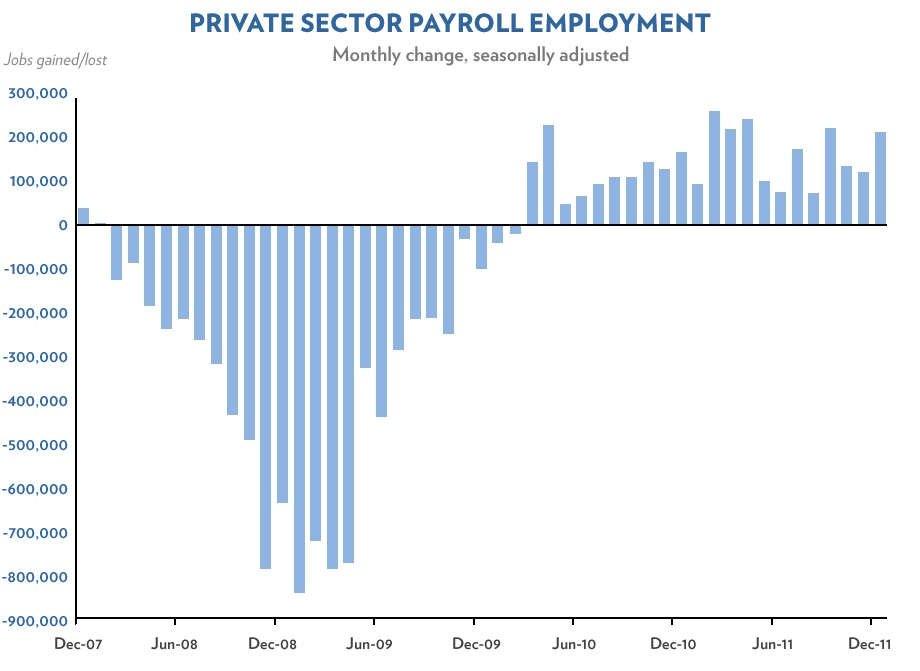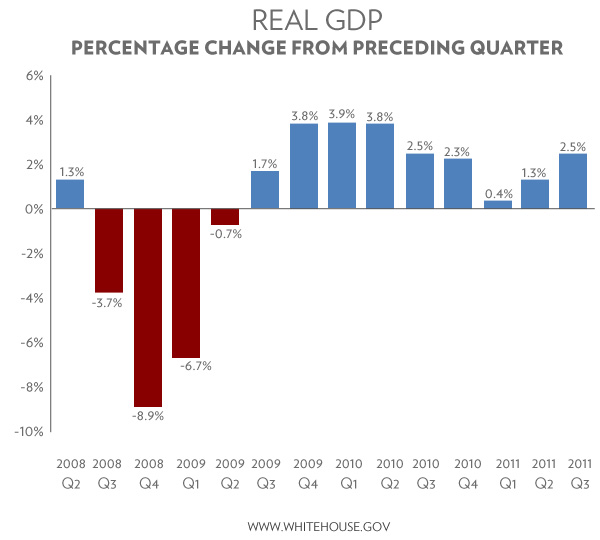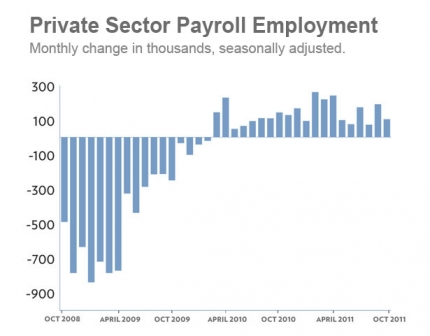Council of Economic Advisers Blog
Chairman Alan Krueger Discusses the Rise and Consequences of Inequality at the Center for American Progress
Posted by on January 12, 2012 at 11:05 AM EDTAt 10:00 ET on Thursday, January 12, 2012, President Obama’s Chairman of the Council of Economic Advisers, Alan B. Krueger delivered remarks on “The Rise and Consequences of Inequality” at the Center for American Progress in Washington, DC.
In his prepared remarks, Chairman Krueger said: "The rise in inequality in the United States over the last three decades has reached the point that inequality in incomes is causing an unhealthy division in opportunities, and is a threat to our economic growth. Restoring a greater degree of fairness to the U.S. job market would be good for businesses, good for the economy, and good for the country."
Read Chairman Krueger’s remarks.
See the related charts as a PDF
See the related charts on slideshare
Learn more about EconomyThe Employment Situation in December
Posted by on January 6, 2012 at 11:36 AM EDTToday’s employment report provides further evidence that the economy is continuing to heal from the worst economic downturn since the Great Depression. It is critical that we continue the economic policies that are helping us to dig our way out of the deep hole that was caused by the recession that began at the end of 2007. Most importantly, we need to extend the payroll tax cut and continue to provide emergency unemployment benefits through the end of this year, and take other steps the President has proposed in the American Jobs Act.
Private sector payrolls increased by 212,000 jobs and overall payroll employment rose by 200,000 jobs in December. The unemployment rate fell 0.2 percentage point to 8.5 percent, the lowest level since February 2009. The drop in unemployment over the month was mostly due to employment growth, not lower labor force participation. The unemployment rate has fallen by 0.9 percentage point in the last 12 months. Despite adverse shocks that have created headwinds for economic growth, the economy has added private sector jobs for 22 straight months, for a total of 3.2 million payroll jobs over that period. In the last 12 months, 1.9 million private sector jobs were added on net, more than in any year since 2005. Nonetheless, we need faster growth to put even more Americans back to work.
Sectors with net job increases in December included transportation and warehousing (+50,200), health care and social assistance (+28,700), retail trade (+27,900), manufacturing (+23,000), leisure and hospitality (+21,000), and construction (+17,000). Local governments lost 14,000 jobs and state government employment was unchanged.
The monthly employment and unemployment numbers are volatile and employment estimates can be subject to substantial revision. Therefore, as the Administration always stresses, it is important not to read too much into any one monthly report.
 Learn more about Economy
Learn more about EconomyChairman Alan Krueger Discusses the Economy at the World Affairs Council of Charlotte
Posted by on December 21, 2011 at 1:45 PM EDTAt 12:45 ET on Wednesday, December 21, 2011, President Obama’s Chairman of the Council of Economic Advisers, Alan B. Krueger delivered his first speech as Chairman at the World Affairs Council of Charlotte, in Charlotte, NC.
Dr. Krueger’s remarks were on “Finding Economic Certainty in an Uncertain World,” where he discussed the risks the US economy faces, the strengths of the US economy, and his belief that there is no amount of uncertainty that we cannot conquer by relying on the durable strengths of what is certain in America.
Read Dr. Krueger's remarks here.
Learn more about EconomyThe Employment Situation in November
Posted by on December 2, 2011 at 10:35 AM EDTToday’s employment report provides further evidence that the economy is continuing to heal from the worst economic downturn since the Great Depression, but the pace of improvement is still not fast enough given the large job losses from the recession that began in December 2007.
Private sector payrolls increased by 140,000 in November and overall payroll employment rose by 120,000. The unemployment rate fell 0.4 percentage point to 8.6 percent, the lowest unemployment rate since March 2009. About half of the drop in unemployment in the household survey was due to a decline in the labor force (-315,000) and about half to employment growth (+278,000). Despite adverse shocks that have created headwinds for economic growth, the economy has added private sector jobs for 21 straight months, for a total of 2.9 million jobs over that period. Nonetheless, we need faster growth to put more Americans back to work.
While the U.S. economy is healing, the world economy continues to be in a fragile state and all economies are linked through trade and finance. In this environment, the President’s American Jobs Act is the right medicine to sustain and strengthen the recovery. In particular, with 13.3 million Americans still unemployed, and 43 percent of them unemployed for 6 months or longer, it would be a setback for the economy and American families if Congress were to allow extended unemployment benefits to expire at the end of the year. The President’s proposal to extend and expand the payroll tax cut for workers and small businesses also would provide a substantial boost to economic growth and job creation.
Sectors with employment increases in November included retail trade (+50,000), professional and business services (+33,000), leisure and hospitality (+22,000), health care and social assistance (+19,000), and manufacturing (+2,000). The temporary help services industry, which is often a leading indicator of future job growth, increased for the fifth month in a row, by 22,300. Sectors with employment declines included government (-20,000) and construction (-12,000). State and local governments lost 16,000 jobs and have shed 430,000 jobs since February 2010.
The monthly employment and unemployment numbers are volatile and employment estimates are subject to substantial revision. Therefore, as the Administration always stresses, it is important not to read too much into any one monthly report.
 Learn more about Economy
Learn more about EconomyThe Employment Situation in October
Posted by on November 4, 2011 at 11:46 AM EDTToday’s employment report provides further evidence that the economy is continuing to recover from the worst economic downturn since the Great Depression, but the pace of improvement is not fast enough.
Private sector payrolls increased by 104,000, and overall payroll employment rose by 80,000 in October. The unemployment rate edged down 0.1 percentage point to 9.0 percent, a level that remains unacceptably high. Despite adverse shocks that have created headwinds for economic growth, the economy has added private sector jobs for 20 straight months, for a total of 2.8 million jobs over that period. We need faster economic growth to put more Americans back to work. Today’s report provides further evidence for why it is so important that Congress pass the President’s American Jobs Act to put more money in the paychecks of working and middle class families; to make it easier for small businesses to hire workers; to keep teachers in the classroom; to put construction crews to work rebuilding our nation’s infrastructure; and other measures that will help the economy grow while not adding to the deficit over ten years. The report underscores that one area that remains notably weak is the construction sector. That’s why it is disappointing that the Senate was not able to proceed to the infrastructure part of the American Jobs Act.
Sectors with employment increases included professional and business services (+32,000), leisure and hospitality (+22,000), retail trade (+17,800), health care and social assistance (+16,300), and manufacturing (+5,000). Sectors with employment declines included government (-24,000) and construction (-20,000). State and local governments lost 22,000 jobs and have shed more than 430,000 jobs since February 2010.
The monthly employment and unemployment numbers are volatile and employment estimates are subject to substantial revision. There is no better example than August’s jobs figure, which was initially reported at zero and in the latest revision increased to 104,000. This illustrates why the Administration always stresses it is important not to read too much into any one monthly report.
Learn more about EconomyAdvance Estimate of GDP for the Third Quarter of 2011
Posted by on October 27, 2011 at 9:39 AM EDTToday’s report shows that the economy posted the ninth straight quarter of positive growth, as real GDP (the total amount of goods and services produced in the country) grew at a 2.5 percent annual rate in the third quarter of this year. The level of real GDP now exceeds its level at the business cycle peak in the fourth quarter of 2007. While the continued expansion is encouraging, faster growth clearly is needed to replace the jobs lost in the recent downturn and to reduce long-term unemployment.
Notable strength in the third quarter included business investment, which grew 16.3 percent at an annual rate. Residential construction increased 2.4 percent at an annual rate, and was up 1.6 percent during the past four quarters, the first positive four-quarter percent change since 2006 except for a brief period when the home buyer tax credit was active. Positive contributions to real GDP growth included consumer spending (1.7 percentage point), fixed investment (1.6 percentage point), and net exports (0.2 percentage point). Inventory investment subtracted 1.1 percentage point from real GDP growth.
We are, nonetheless, at a fragile moment in the world economy, and cannot afford to do anything to undermine our economic recovery. That’s why the President continues to urge Congress to pass the American Jobs Act without delay. The American Jobs Act includes measures that would accelerate the recovery, including extending the payroll tax cut and unemployment insurance, keeping teachers in the classroom and police and firefighters on the beat, and investing in our nation’s infrastructure to help put Americans back to work. Independent economists say it could increase employment by up to 1.9 million, increase growth and lower the unemployment rate. This report also underscores the need to put in place a balanced approach to deficit reduction that phases in budget cuts, instills confidence, and allows us to live within our means without shortchanging future growth.
.
 Learn more about Economy
Learn more about Economy
- &lsaquo previous
- …
- 17
- 18
- 19
- 20
- 21
- 22
- 23
- 24
- 25
- …
- next &rsaquo
White House Blogs
- The White House Blog
- Middle Class Task Force
- Council of Economic Advisers
- Council on Environmental Quality
- Council on Women and Girls
- Office of Intergovernmental Affairs
- Office of Management and Budget
- Office of Public Engagement
- Office of Science & Tech Policy
- Office of Urban Affairs
- Open Government
- Faith and Neighborhood Partnerships
- Social Innovation and Civic Participation
- US Trade Representative
- Office National Drug Control Policy
categories
- AIDS Policy
- Alaska
- Blueprint for an America Built to Last
- Budget
- Civil Rights
- Defense
- Disabilities
- Economy
- Education
- Energy and Environment
- Equal Pay
- Ethics
- Faith Based
- Fiscal Responsibility
- Foreign Policy
- Grab Bag
- Health Care
- Homeland Security
- Immigration
- Innovation Fellows
- Inside the White House
- Middle Class Security
- Open Government
- Poverty
- Rural
- Seniors and Social Security
- Service
- Social Innovation
- State of the Union
- Taxes
- Technology
- Urban Policy
- Veterans
- Violence Prevention
- White House Internships
- Women
- Working Families
- Additional Issues


